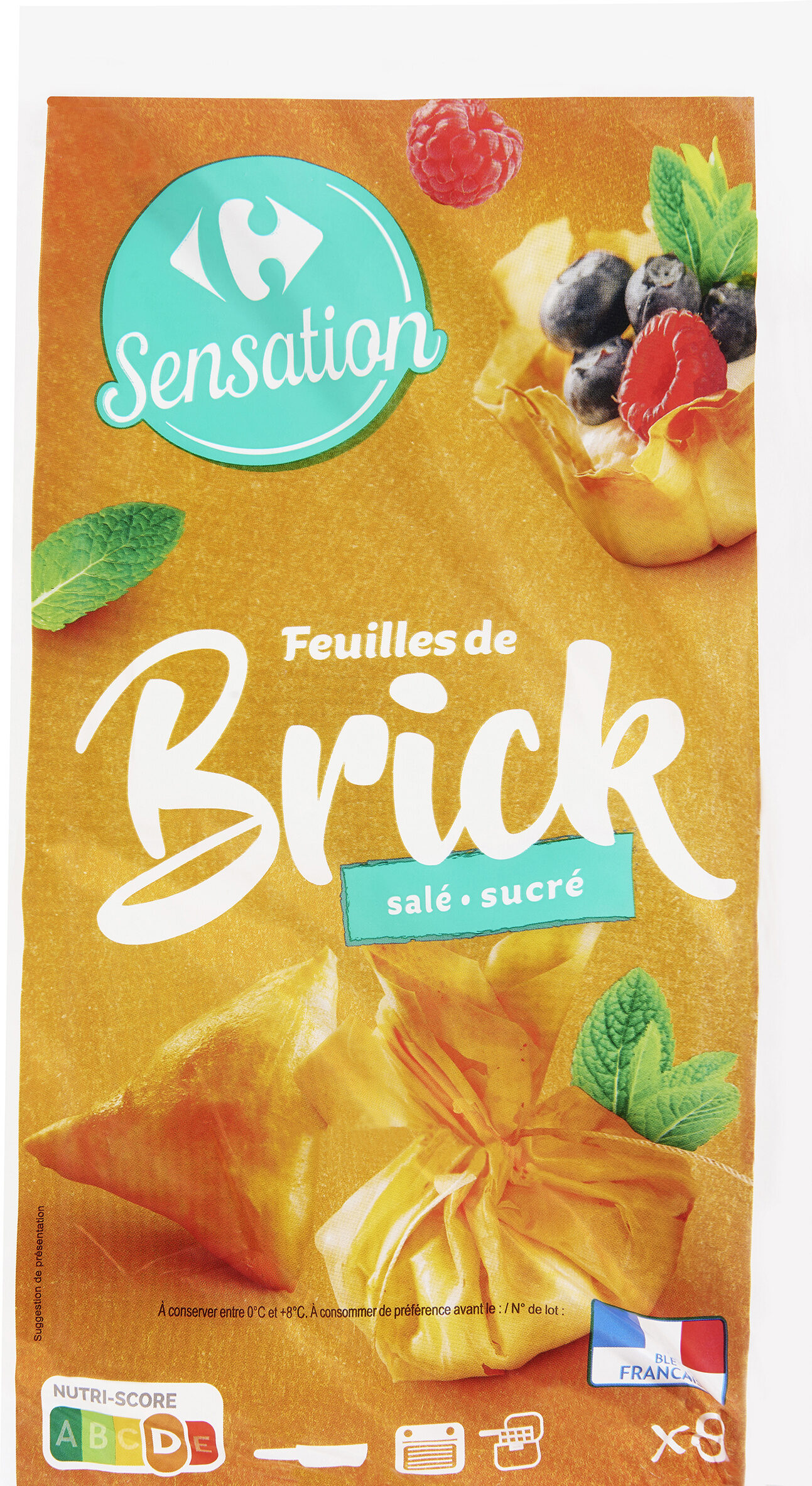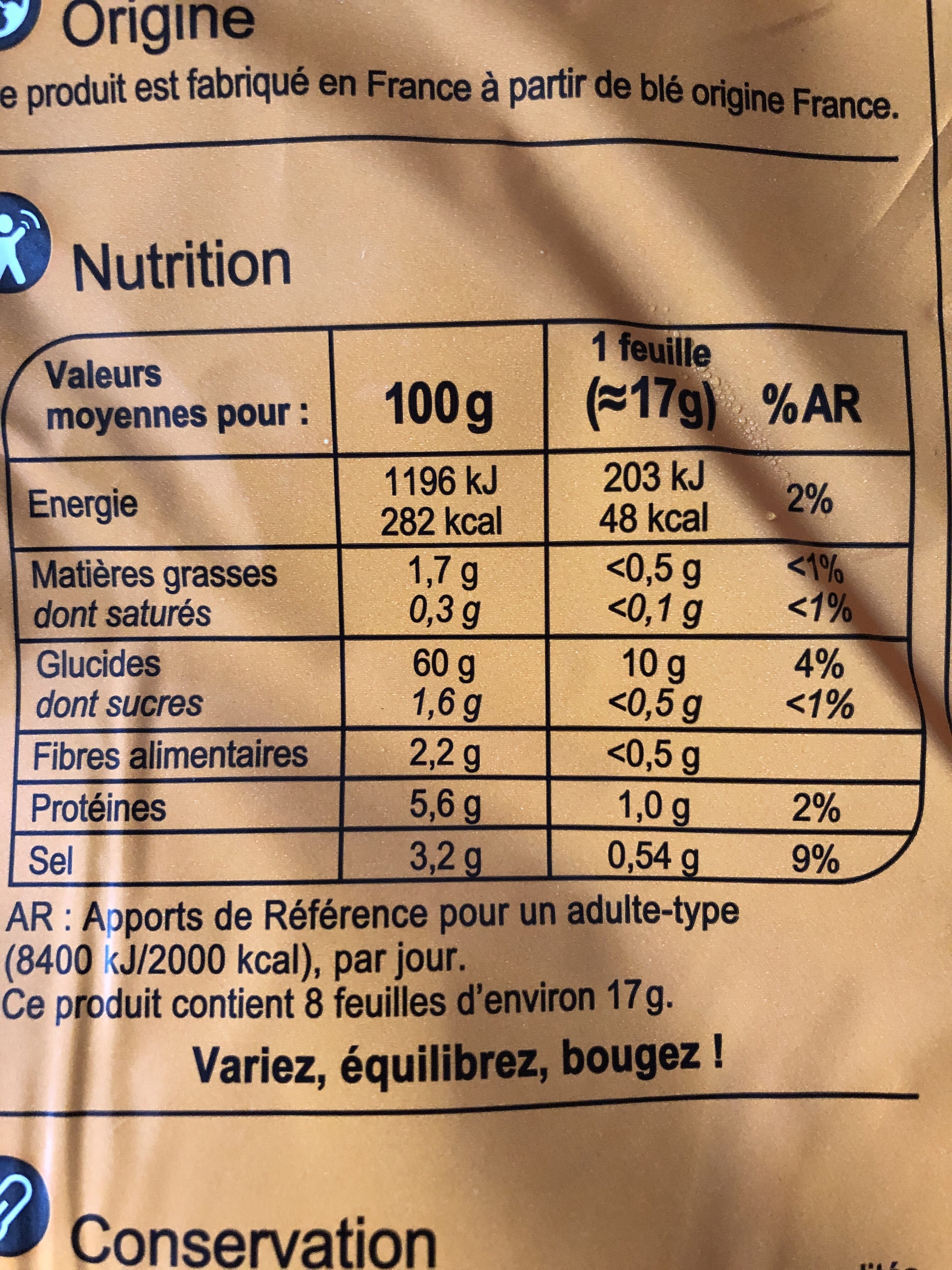Feuilles de Brick Salé Sucré - Carrefour - 136 g
This product page is not complete. You can help to complete it by editing it and adding more data from the photos we have, or by taking more photos using the app for Android or iPhone/iPad. Thank you!
×
Some of the data for this product has been provided directly by the manufacturer Carrefour.
Barcode: 3560070454747 (EAN / EAN-13)
Common name: Feuilles de brick.
Quantity: 136 g
Brands: Carrefour
Categories: Plant-based foods and beverages, Plant-based foods, Cereals and potatoes, Cereals and their products, Pie dough, Brick sheets
Labels, certifications, awards: Made in France, Nutriscore, fr:Blé français
Origin of the product and/or its ingredients: Ce produit est fabriqué en France à partir de blé origine France.
Producer: Fabriqué en France par EMB 95268C pour Interdis.
Traceability code: EMB 95268C - Garges-lès-Gonesse (Val-d'Oise, France)
Stores: Carrefour, carrefour.fr
Countries where sold: France
Matching with your preferences
Environment
Packaging
Transportation
Other information
Other information: x8 Feuilles pliées Fabriqué en France Blé origine France Picto modes de cuisson (four, poêle, friteuse)
Preparation: Pliage en samoussa : 1. Dépliez la feuille de brick. 2. Coupez-la en deux et rabattez la partie arrondie sur le bord. 3. Déposez la garniture à une extrémité. 4. Rabattez la feuille avec la farce à l'intérieur. 5. Rabattez dans l'autre sens pour former un triangle, répétez l'opération jusqu'à ce qu'il ne reste de place que pour un seul triangle. 6. Vous pouvez soit replier la dernière partie vide à l'intérieur du triangle, soit badigeonner le dernier triangle vide de jaune d'œuf battu et le rabattre. Cuisson : Vous pouvez varier les formes de vos préparations (aumônières, cigares, ...) et les faire dorer quelques minutes en surveillant bien la cuisson à la friteuse ou à la poêle dans un bain d'huile bien chaude, ou au four environ 7 min à 180°C.
Recipe idea: BRICK / SAMOUSSAS CHEVRE NOIX : Pour 4 personnes 4 feuilles de brick – 1 beau chèvre moelleux et rond – 50 g de cerneaux de noix – 1 c. à soupe d'huile de tournesol – 4 c. à café de miel Cuisson au four Préchauffez le four à 180°C. Coupez le chèvre en 8 parts égales de 1 cm d'épaisseur. 1. Dépliez la feuille de brick. 2. Coupez-la en deux et rabattez la partie arrondie vers le bord. 3. Déposez une part de chèvre à une extrémité de la brick, déposez des morceaux de noix dessus puis une ½ c. à café de miel. 4. Rabattez la feuille avec la farce à l'intérieur. 5. Rabattez à nouveau la feuille dans l'autre sens pour former un triangle, répétez l'opération jusqu'à ce qu'il ne reste de place que pour un seul triangle. 6. Vous pouvez soit replier la dernière partie vide à l'intérieur du triangle, soit badigeonner le dernier triangle vide de jaune d'œuf battu et le rabattre. A l'aide d'un pinceau, enduisez vos samoussas d'huile pour un rendu doré. Déposez sur une plaque allant au four. Faites cuire 7 minutes environ. Servez chaud avec un cerneau de noix pour décorer et accompagnez d'une salade verte.
Warning: Ne pas utiliser le papier paraffiné qui se trouve entre les feuilles de brick pour la cuisson.
Conservation conditions: À conserver entre 0°C et +8°C. Afin de conserver les qualités organoleptiques de votre produit, nous vous conseillons de bien refermer le sachet après chaque utilisation.
Customer service: Interdis - TSA 91431 - 91343 MASSY Cedex - France
Report a problem
Data sources
Product added on by openfoodfacts-contributors
Last edit of product page on by org-carrefour.
Product page also edited by autorotate-bot, carrefour, date-limite-app, desan, driveoff, kiliweb, packbot, roboto-app, teolemon, yuka.V3IwQVRyUWN2OFVKdU1jUStpanQ0OHRPMm9XelRVTzZFOFFCSWc9PQ.










